Related Research Articles

Louis Stephen St. Laurent was a Canadian lawyer and politician who served as the 12th prime minister of Canada from 1948 to 1957.

William Lyon Mackenzie King was a Canadian statesman and politician who served as the tenth prime minister of Canada for three non-consecutive terms from 1921 to 1926, 1926 to 1930, and 1935 to 1948. A Liberal, he was the dominant politician in Canada from the early 1920s to the late 1940s. King is best known for his leadership of Canada throughout the Great Depression and the Second World War. He played a major role in laying the foundations of the Canadian welfare state and established Canada's international reputation as a middle power fully committed to world order. With a total of 21 years and 154 days in office, he remains the longest-serving prime minister in Canadian history.

John Buchan, 1st Baron Tweedsmuir was a Scottish novelist, historian, and Unionist politician who served as Governor General of Canada, the 15th since Canadian Confederation.

The Caroline affair was an international incident involving the United States, the United Kingdom, and the Canadas which started in 1837 and lasted until 1842. While ultimately a minor historical event, it eventually acquired substantial international legal significance.

Major-General Alexander Cambridge, 1st Earl of Athlone, was a member of the extended British royal family and a British Army commander, who served as Governor-General of the Union of South Africa and Governor General of Canada.
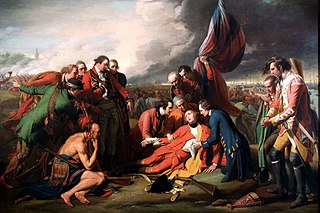
Events from the year 1944 in Canada.
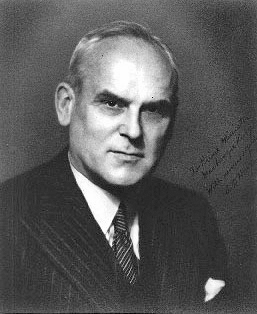
Clarence Decatur Howe, was an American-born Canadian engineer, businessman and Liberal Party politician. Howe served as a cabinet minister in the governments of prime ministers William Lyon Mackenzie King and Louis St. Laurent continuously from 1935 to 1957. He is credited with transforming the Canadian economy from agriculture-based to industrial. During the Second World War, his involvement in the war effort was so extensive that he was nicknamed the "Minister of Everything".

The 1945 Canadian federal election was held on June 11, 1945, to elect members of the House of Commons of the 20th Parliament of Canada. Prime Minister William Lyon Mackenzie King's Liberal government was re-elected to its third consecutive term, although this time with a minority government as the Liberals fell five seats short of a majority.
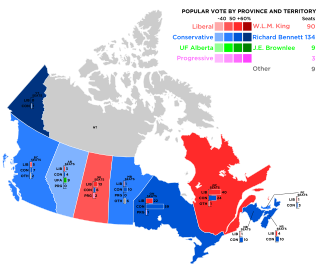
The 1930 Canadian federal election was held on July 28, 1930, to elect members of the House of Commons of the 17th Parliament of Canada. Richard Bedford Bennett's Conservative Party won a majority government, defeating the Liberal Party led by Prime Minister William Lyon Mackenzie King.
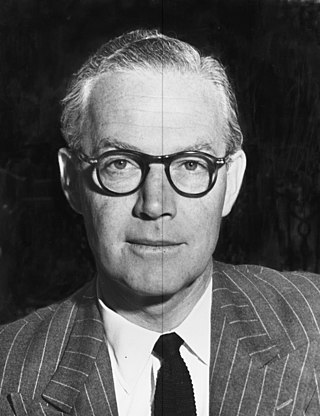
Arnold Danford Patrick Heeney, was a Canadian lawyer, diplomat and civil servant.
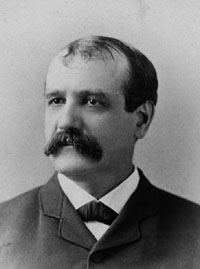
Francis Amasa Walker was an American economist, statistician, journalist, educator, academic administrator, and an officer in the Union Army.
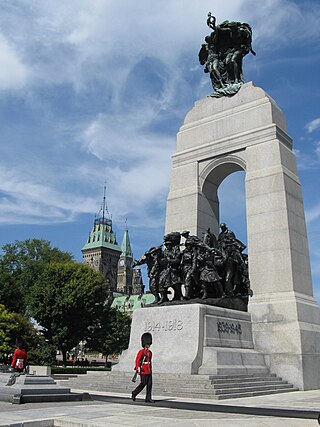
The National War Memorial, titled The Response, is a tall, granite memorial arch with accreted bronze sculptures in Ottawa, Ontario, designed by Vernon March and first dedicated by King George VI in 1939. Originally built to commemorate the Canadians who died in the First World War, it was in 1982 rededicated to also include those killed in the Second World War and Korean War and again in 2014 to add the dead from the Second Boer War and War in Afghanistan, as well as all Canadians killed in all conflicts past and future. It now serves as the pre-eminent war memorial of 76 cenotaphs in Canada. In 2000, the Tomb of the Unknown Soldier was added in front of the memorial and symbolizes the sacrifices made by all Canadians who have died or may yet die for their country.
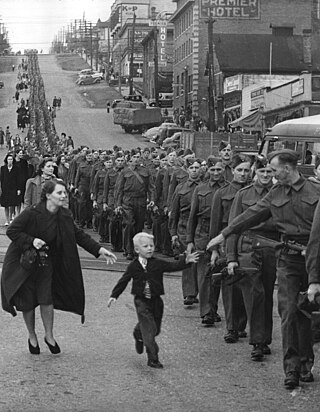
During the World Wars and Interwar Years, 1914–1947, Canada experienced economic gain, more freedom for women, and new technological advancements. There were severe political tensions over issues of war and ethnicity, and heavy military casualties. The Great Depression hit Canada hard, especially in export-oriented mining and farming communities, and in urban factory districts.

Lester Bowles "Mike" Pearson was a Canadian politician, diplomat, statesman, and scholar who served as the 14th prime minister of Canada from 1963 to 1968.

Joseph-Roméo-Liguori Lacombe, generally known as Liguori Lacombe, was a Member of Parliament in the House of Commons of Canada from 1925 to 1930 and again from 1935 to 1948. He is best known for having quit the Liberal Party of Canada because of his isolationist opposition to Canada's entry into World War II and for campaigning against the government during the Conscription Crisis of World War II.
David Luther Burgess MC MBE was a World War I flying ace who, in 1926, was the sole challenger to Liberal Prime Minister William Lyon Mackenzie King in a by-election held in Prince Albert, Saskatchewan.
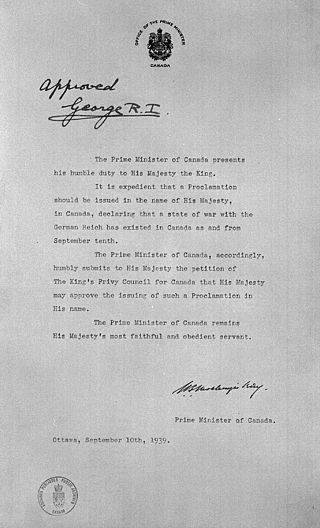
A declaration of war by Canada against Germany was made by order-in-council signed by George VI, king of Canada, on 10 September 1939, seven days after the United Kingdom and France had also entered a state of war with the Nazi regime. The royal proclamation of the Canadian declaration was published in the Canada Gazette.
Frank Cunningham was a Canadian lawyer and public servant.
The foreign policies of Canada and its predecessor colonies were under British control until the 20th century. This included wars with the United States in 1775-1783 and 1812–1815. Economic ties with the U.S. were always close. Political tensions arose in the 19th century from anti-British feeling in the U.S. in the 1860s. Boundary issues caused diplomatic disputes resolved in the 1840s over the Maine boundary. and early 1900s, in the early 20th century over the Alaska boundary. There is ongoing discussion regarding the Arctic. Relations have been very friendly with the U.S. in the 20th and 21st centuries.
References
- ↑ Corcelli, John (August 2005). "The Days Before Yesterday". Canadian Communications Foundation. Retrieved 7 May 2010.